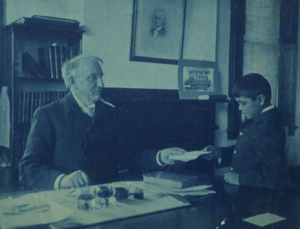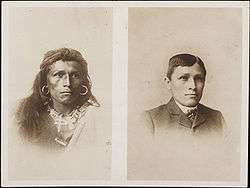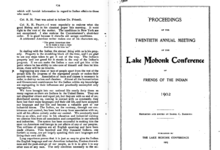Richard Henry Pratt

Richard Henry Pratt (December 6, 1840 – March 15, 1924)[1] is best known as the founder and longtime superintendent of the influential Carlisle Indian Industrial School at Carlisle, Pennsylvania. He is associated with the first recorded use of the word "racism", which he used in 1902 to criticize against racial segregation, as well as the phrase "kill the Indian... and save the man" in reference to the efforts to educate Native Americans.[2]
Early life
Pratt was born on December 6, 1840 in Rushford, New York to Richard and Mary Pratt (née Herrick). He was the eldest of their three sons. He contracted smallpox as a young child which left him with facial scarring for the rest of his life. His father moved the family to Logansport, Indiana in 1847. Pratt's father later left his family to take part in the California Gold Rush in 1849 but was robbed and murdered by another prospector leaving Pratt to support his mother and two brothers.[3]
Military career
At the outbreak of the American Civil War Pratt enlisted in the 9th Indiana Infantry Regiment. After his first three-month term expired he re-enlisted as a sergeant with the 2nd Regiment Indiana Cavalry and saw action at the Battle of Chickamauga. While on a recruiting detail in Indiana during the winter of 1863-1864 Pratt met Anna Mason. They were married on April 12, 1864. Eight days later he was commissioned as a first lieutenant with the 11th Regiment Indiana Cavalry. He served in administrative roles for the remainder of the war and was mustered out of the Volunteer Service on May 29, 1865 at the rank of captain.[3]
He became a companion of the Military Order of the Loyal Legion of the United States - a military society for officers who had served the Union during the Civil War.
Pratt returned to Logansport, Indiana to be reunited with Anna and ran a hardware store. After two years in the hardware business, he re-entered the Army in March 1867 as Second Lieutenant in the 10th United States Cavalry, an African-American regiment composed of freedman and recently freed slaves famously known as the "Buffalo Soldiers" at Fort Sill in the Oklahoma Territory.
Pratt's long and active military career included eight years in the great plains, which involved participation in some of the signal conflicts with Native Americans of the southern plains, including the Washita campaign of 1868–1869 and the Red River War of 1874–1875. The winter of 1874-1875 caused many hostiles to surrender to their Indian Agents and Pratt was responsible for gathering testimony for and against the worst offenders. He worked directly with interpreters and prisoners to clear as many charges as possible.[4]
He was promoted to captain in February 1883; major in July 1898; lieutenant colonel in February 1901; and to colonel in January 1903. He retired from the Army in February 1903 and in April 1904 he was advanced to brigadier general on the Retired List.
Fort Marion and Carlisle

After the Indian wars subsided President Grant's Attorney General concluded that a state of war could not exist between a nation and its wards therefore the prisoners would be sent as prisoners of war for permanent imprisonment at Fort Marion. Pratt was chosen to lead the prisoners because he had much experience with Indians and interpreters from working on their cases. His orders were extremely vague so after he requested further authority over the prisoners he began to experiment with education.[5] In the 1870s at Fort Marion, Florida, he introduced classes in the English language, art, guard duty, and craftsmanship to several dozen prisoners who had been chosen from among those who had surrendered in the Indian Territory at the end of the Red River War.[6]
On November 1, 1879, he founded the Carlisle Indian Industrial School at Carlisle, Pennsylvania, the first of many nonreservation boarding schools for Native Americans.
Pratt did not regard his innovations at Fort Marion as limited to Native Americans only. He developed the compulsory education paradigm that would be used for many different demographic minorities in the United States and its territories, including African-Americans, Puerto Ricans, Mexicans, Latinos, Pacific Islanders, Asian-Americans, and Mormons.[6] He took his pedagogical inspiration from the Puritans.[7]
Cultural assimilation of Native Americans

Pratt's practice of Americanization of Native Americans by forced cultural assimilation, which he effected both at Fort Marion and Carlisle, was later regarded by some as a form of cultural genocide.[6] He believed that to claim their rightful place as American citizens, Native Americans needed to renounce their tribal way of life, convert to Christianity, abandon their reservations, and seek education and employment among the "best classes" of Americans. In his writings he described his belief that the government must "kill the Indian...to save the man".[8]
Pratt was outspoken and a leading member of what was called the "Friends of the Indian" movement at the end of the 19th century. He believed in the "noble" cause of civilizing the Indians. He said, "The Indians need the chances of participation you have had and they will just as easily become useful citizens."[9] At Fort Marion and Carlisle, he sanctioned beatings to force Native Americans to stop speaking their own respective languages. Later schools run by the Bureau of Indian Affairs in the Carlisle model were marked by kidnapping and imprisonment of children at the schools, disease, sexual abuse, and suicide.
Nevertheless, Pratt's approach was distinct for its time in as much as he regarded Native Americans as being worthy of respect and help, and capable of full participation in society, whereas most of his contemporaries regarded Native Americans as nearly subhuman, who could never be lifted into mainstream American society.

Pratt became an outspoken opponent of tribal segregation on reservations. He believed the system as administered and encouraged by the Bureau of Indian Affairs was hindering the education and civilization of Native Americans and creating helpless wards of the state. These views led to conflicts with the Indian Bureau and the government officials who supported the reservation system. In May, 1904 Pratt denounced the Indian Bureau and the reservation system as a hindrance to the civilization and assimilation of Native Americans. This controversy, coupled with earlier disputes with the government over civil service reform, led to Pratt's forced retirement as superintendent of the Carlisle School on June 30, 1904.
This did not, however, end Pratt's support for Native American causes. A tireless speaker and letter writer, he continued his campaign for fair and humane treatment of the Native American. The legacy of Pratt's boarding school programs is felt by modern Native American tribes, where he is often remembered not as a champion for Native American rights but as leader of a cultural genocide that targeted children.[10][11]
Retirement
From his home in Rochester, New York, during his retirement years, Pratt continued to lecture and argue his viewpoints, but without great success. He died on March 15, 1924, at the Letterman Army Hospital in the Presidio of San Francisco and was buried in Arlington National Cemetery.
Wayne Rogers portrayed Pratt in the 1965 episode "The Journey" of the syndicated western television series, Death Valley Days. In the same episode, Robert J. Wilke played Sergeant Wilks, who advocates a more harsh treatment of Indian prisoners than does Pratt. Leonard Nimoy was cast as Yellow Bear.[12]
In the 2005 miniseries, Into the West, produced by Steven Spielberg and DreamWorks, Pratt is played by Keith Carradine. His role at the Carlisle School is addressed in the 2008 documentary, Our Spirits Don't Speak English.
See also
Notes
- ↑ K.B. Kueteman. "From Warrior to Saint: The life of David Pendelton Oakerhater". Oklahoma State.
- ↑ Gene Demby. The Ugly, Fascinating History Of The Word 'Racism'. NPR.org. January 6, 2014. Accessed November 11, 2016.
- 1 2 Anderson, H. Allen. "Pratt, Richard Henry". Texas State Historical Association. Retrieved 5 February 2015.
- ↑ Richard Henry Pratt, Battlefield and Classroom.
- ↑ Richard Henry Pratt, Battlefield and Classroom
- 1 2 3 Removing Classrooms from the Battlefield: Liberty, Paternalism, and the Redemptive Promise of Educational Choice, 2008 BYU Law Review 377
- ↑ Quaqua Society – Massachusetts Bay Colony.
- ↑ Bear, Charla. May 12, 2008, NPR, "American Indian Boarding Schools Haunt Many". Accessed September 2, 2014.
- ↑ Pratt, Richard Henry. Battlefield & Classroom. Norman, University of Oklahoma Press, 2003. p 215
- ↑ Smith, Andrea. “Soul Wound: The Legacy of Native American Schools.” Web. 1 Nov. 2010. http://www.amnestyusa.org/amnestynow/soulwound.html
- ↑ Adams, David Wallace. "Education for Extinction". (1995). University Press of Kansas. ISBN 978-0-7006-0838-6
- ↑ "The Journey". Internet Movie Data Base. March 29, 1965. Retrieved August 25, 2015.
Bibliography
- Pratt, Richard Henry (2004). Battlefield and Classroom: Four Decades with the American Indian, 1867–1904. Norman: University of Oklahoma Press. ISBN 0-8061-3603-0.
- Eastman, Alaine Goodale (1935). Pratt, the Red Man's Moses. Norman: University of Oklahoma Press. LCCN 35021899.
- Haley, James L. (1976). The Buffalo War: The History of the Red River Indian Uprising of 1874. Garden City, New York: Doubleday. ISBN 0-385-06149-8.
- Richard Henry Pratt Papers. Yale Collection of Western Americana, Beinecke Rare Book and Manuscript Library.
External links
| Wikisource has original works written by or about: Richard Henry Pratt |
- Works by or about Richard Henry Pratt at Internet Archive
- Richard Henry Pratt Papers. Yale Collection of Western Americana, Beinecke Rare Book and Manuscript Library.
